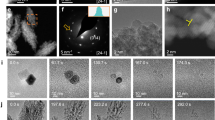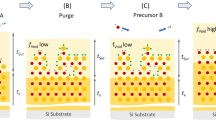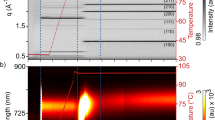Abstract
Growth and dissolution of crystal surfaces are central to processes as diverse as pharmaceutical manufacturing1,2, corrosion3, single-crystal production4 and mineralization in geochemical and biological environments5,6. Impurities are either unavoidable features of these processes or intentionally introduced to modify the products. Those that act as inhibiting agents induce a so-called ‘dead zone’, a regime of low supersaturation where growth ceases. Models based on the classic theory of Cabrera and Vermilyea7 explain behaviour near the dead zone in terms of the pinning of elementary step motion by impurities8,9. Despite general acceptance of this theory, a number of commonly investigated systems exhibit behaviour not predicted by such models10. Moreover, no clear microscopic picture of impurity–step interactions currently exists. Here we use atomic force microscopy to investigate the potassium dihydrogen phosphate {100} surface as it emerges from the dead zone. We show that traditional models are not able to account for the behaviour of this system because they consider only elementary steps, whereas it is the propagation of macrosteps (bunches of monolayer steps) that leads to resurrection of growthout of the dead zone. We present a simple physical model of this process that includes macrosteps and relates characteristics of growth near the dead zone to the timescale for impurity adsorption.
This is a preview of subscription content, access via your institution
Access options
Subscribe to this journal
Receive 51 print issues and online access
$199.00 per year
only $3.90 per issue
Buy this article
- Purchase on Springer Link
- Instant access to full article PDF
Prices may be subject to local taxes which are calculated during checkout



Similar content being viewed by others
References
McPherson, A. Crystallization of Biological Macromolecules(Cold Spring Harbor Laboratory Press, Cold Spring Harbor, New York, (1999).
Malkin, A. J.et al. Mechanisms of growth for protein and virus crystals. Nature Struct. Biol. 2, 956–959 (1995).
ASM Handbook Vol. 13, Corrosion(eds Davis, J. R. et al.) (American Society for Materials, Materials Park, Ohio, (1987).
Zaitseva, N. P. et al. Rapid growth of large-scale (40–55 cm) KH2PO4crystals. J. Cryst. Growth 180, 255–262 (1997).
Pina, C. M., Becker, U., Risthaus, P., Bosbach, D. & Putnis, A. Molecular-scale mechanisms of crystal growth in barite. Nature 395, 483–486 (1998).
Teng, H. H., Dove, P. M., Orme, C. A. & De Yoreo, J. J. The thermodynamics of calcite growth: a baseline for biomineralization. Science 282, 724–727 (1998).
Cabrera, N. & Vermilyea, D. A. Growth and Perfection of Crystals 393 (Chapman and Hall, London, (1958).
Potapenko, S. Y Moving of steps through an impurity fence. J. Cryst. Growth 133, 147–154 (1993).
van Enckevort, W. J. P. & van den Berg, A. C. J. F. Impurity blocking of crystal growth: a Monte Carlo study. J. Cryst. Growth 183, 441–455 (1998).
Rashkovich, L. N. & Kronsky, N. V. Influence of Fe3+ and Al3+ ions on the kinetics of steps on the {100} faces of KDP. J. Cryst. Growth 182, 434–441 (1997).
Zaitseva, N. P., Carman, L., Smolsky, I., Torres, R. & Yan, M. The effect of supersaturation and impurities on the rapid growth of KDP crystals. J. Cryst. Growth(in press).
Rashkovich, L. N. KDP Family of Crystals(Adam-Hilger, New York, (1991).
Dam, B., Bennema, P. & Van Enckevort, W. J. P. In situ observation of surface phenomena on {100} and {101} potassium dihydrogen phosphate crystals. J. Cryst. Growth 69, 306–316 (1986).
Land, T. A., De Yoreo, J. J. & Lee, J. D. An in situ AFM investigation of canavalin crystallization kinetics. Surf. Sci. 384, 136–155 (1997).
Acknowledgements
We thank L. Carman for providing the starting solutions, R. Torres for chemical analyses, P. Rock and W. Casey for use of equipment, and the NSF for support. This work was performed under the auspices of the US Department of Energy by Lawrence Livermore National Laboratory.
Author information
Authors and Affiliations
Corresponding author
Rights and permissions
About this article
Cite this article
Land, T., Martin, T., Potapenko, S. et al. Recovery of surfaces from impurity poisoning during crystal growth. Nature 399, 442–445 (1999). https://doi.org/10.1038/20886
Received:
Accepted:
Issue Date:
DOI: https://doi.org/10.1038/20886
This article is cited by
-
Out-of-sequence skeletal growth causing oscillatory zoning in arc olivines
Nature Communications (2021)
-
The mechanism of eutectic modification by trace impurities
Scientific Reports (2019)
-
Direct Synthesis of Novel and Reactive Sulfide-modified Nano Iron through Nanoparticle Seeding for Improved Cadmium-Contaminated Water Treatment
Scientific Reports (2016)
-
Effects of EDTA additives on optical properties of rapidly grown KDP single crystals
Journal of Materials Science: Materials in Electronics (2015)
-
Effect of supersaturation on hillock of directional Growth of KDP crystals
Scientific Reports (2014)
Comments
By submitting a comment you agree to abide by our Terms and Community Guidelines. If you find something abusive or that does not comply with our terms or guidelines please flag it as inappropriate.



